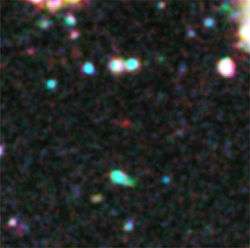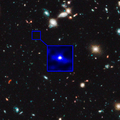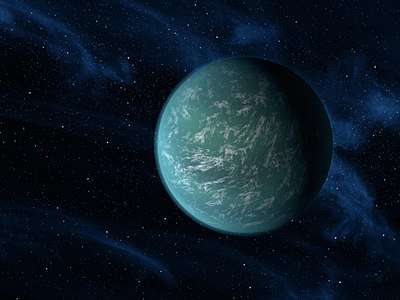UDFj-39546284
UDFj-39546284 is the designation given to a stellar structure reported on January 27, 2011,[5] as light from the oldest object detected through infrared[6] observation within the Hubble Space Telescope. The object, located in the Fornax constellation, was identified by G. Illingworth (UC Santa Cruz), R. Bouwens (UC Santa Cruz and Leiden University) and the HUDF09 Team during 2009 and 2010.[7][8] It was initially thought (November 2012) to be at redshift z~10 using Hubble and Spitzer telescope photometric data, including Hubble Extreme Deep Field (XDF).[3] Subsequently, it was reported (December 2012) to possibly be at a record-breaking redshift z = 11.9[2] using Hubble and Spitzer telescope data, including Hubble Ultra-Deep Field (HUDF).[2][3] Recent analyses (March 2013) have suggested this source is more likely to be a low redshift interloper, with extreme emission lines in its spectrum producing the appearance of a very high redshift source.[4][3]
| UDFj-39546284 | |
|---|---|
 Hubble Space Telescope image of UDFj-39546284 (seen as a reddish spot in the center of the image) | |
| Observation data | |
| Constellation | Fornax |
| Right ascension | 03h 32m 39.54s[1] |
| Declination | −27° 46′ 28.4″[1] |
| Redshift | uncertain [1] [3][4] |
| Apparent magnitude (V) | V fainter than 30.1[1] H160 = 28.92 ± 0.18[1] J125 – H160 > 2[1] |
| Other designations | |
| [MDB2013] UDF12-3954-6285 | |
Gallery
 UDFj-39546284
UDFj-39546284 UDFj-39546284 appears as a faint red blob
UDFj-39546284 appears as a faint red blob
See also
References
- R.J. Bouwens; G.D. Illingworth; I. Labbe; P.A. Oesch; M. Carollo; M. Trenti; P.G. van Dokkum; M. Franx; M. Stiavelli; V. Gonzalez; D. Magee; Bradley (2011). "A candidate redshift z ~ 10 galaxy and rapid changes in that population at an age of 500 Myr". Nature. 469 (7331): 504–507. arXiv:0912.4263. Bibcode:2011Natur.469..504B. doi:10.1038/nature09717. PMID 21270889.
- Wall, Mike (December 12, 2012). "Ancient Galaxy May Be Most Distant Ever Seen". Space.com. Retrieved December 12, 2012.
- Bouwens, R. J.; Oesch, P. A.; Illingworth, G. D.; Labbé, I.; Van Dokkum, P. G.; Brammer, G.; Magee, D.; Spitler, L. R.; Franx, M.; Smit, R.; Trenti, M.; Gonzalez, V.; Carollo, C. M. (2013). "Photometric Constraints on the Redshift of z ~ 10 Candidate UDFj-39546284 from Deeper WFC3/IR+ACS+IRAC Observations over the HUDF". The Astrophysical Journal Letters. 765 (1): L16. arXiv:1211.3105. Bibcode:2013ApJ...765L..16B. doi:10.1088/2041-8205/765/1/L16.
- Brammer, Gabriel B.; Van Dokkum, Pieter G.; Illingworth, Garth D.; Bouwens, Rychard J.; Labbé, Ivo; Franx, Marijn; Momcheva, Ivelina; Oesch, Pascal A. (2013). "A Tentative Detection of an Emission Line at 1.6 μm for the z ~ 12 Candidate UDFj-39546284". The Astrophysical Journal Letters. 765 (1): L2. arXiv:1301.0317. Bibcode:2013ApJ...765L...2B. doi:10.1088/2041-8205/765/1/L2.
- C Petit writing for Knight Science Journalism at MIT - tracker Retrieved 2012-08-10
- A Mann writing for a Nature magazine (online) article Retrieved 2012-08-10 – this article references – Bouwens, R. J. et al. Nature 469, 504–507 (2011). 2.Yan, H.-J. et al. Res. Astron. Astrophys. 10, 867–904 (2010). 3.Kistler, M. D., Yüksel, H., Beacom, J. F., Hopkins, A. M. & Wyithe, J. S. B. Astrophys. J. 705, L104-L108 (2009)
- Staff (January 28, 2011). "Most Distant Galaxy Candidate Ever Seen in Universe". NASA. Retrieved December 13, 2012.
- Staff. "Picture Album: Gray-scale Image of Object UDFj-39546284 from HUDF WFC3/IR". Space Telescope Science Institute. Retrieved December 13, 2012.
External links
| Wikimedia Commons has media related to UDFj-39546284. |
| Preceded by UDFy-38135539 |
Most distant astronomical object known 2011 — 2012 |
Succeeded by MACS0647-JD |
| Preceded by MACS0647-JD |
Most distant astronomical object known 2012 |
Succeeded by BDF-3299 |
| Preceded by UDFy-38135539 |
Most distant galaxy known 2011 — 2012 |
Succeeded by MACS0647-JD |
| Preceded by MACS0647-JD |
Most distant galaxy known 2012 |
Succeeded by BDF-3299 |


.jpg)